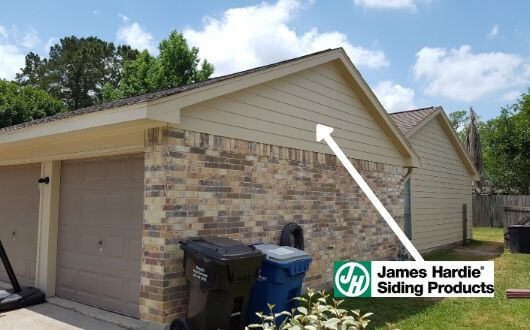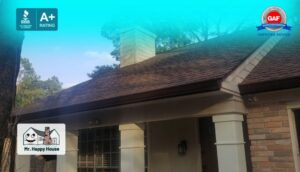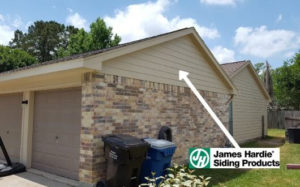
Best GAF Certified Roofers in The Woodlands, TX – Quality Roof Replacement, Gutters & Siding
Best GAF Certified Roofers in The Woodlands, TX – Quality Roof Replacement, Gutters & Siding Best GAF Certified Roofers in The Woodlands, TX – Quality

Not many homeowners think about replacing the siding on their house. It is more common for a homeowner to think about repainting the exterior of their house than it is to think about replacing the siding that lies underneath the paint. So, how often does siding need to be replaced on a house?
Well, there are a few different types of siding available and each one has a different lifespan. This article is going to look into the different types of siding and how often they need to be replaced. We are also going to discuss the different signs that homeowners should be aware of that could determine if their siding needs to be redone. Our team at Mr. Happy House can help determine any underlying damage and we can replace any existing siding on a house.
Each different type of siding has a different life expectancy. There are a few different things that go into determining the longevity and durability of each siding. Many types of siding are susceptible to moisture, and not as susceptible to scratches and dents. While other types of siding are prone to dents and cracking, but not as susceptible to moisture.
The contractor that installs the siding also determines how long the siding will last before needing a replacement. We at Mr. Happy House do everything we can to ensure the siding will last as long as possible. It is important to mention that the homeowner is still responsible for regular cleaning and monitoring, as this helps increase the lifespan of the siding.
Cedarwood siding is a natural wood siding made from red or white cedar. Cedarwood siding is beautiful and can give a home a warm aesthetic, but many planks will need to be replaced every 10-15 years.
Cedarwood siding can last longer if it is properly installed and maintained. Since cedar is a natural wood it is very susceptible to moisture, especially around windows and doors. Moisture damage can be slightly prevented by painting or staining the cedar.
However, the paint or stain can fade, chip, and peel. Regular cleanings of cedar siding can help prolong its lifespan as it is prone to the accumulation of dirt and debris. That is why it is recommended to wash the siding twice a year.
Engineered wood siding is made of thin strips of wood that have been pressed and bonded together. A resin material bonds the strips together and adds a layer of protection against insect activity and rot.
Engineered wood siding should last 20 to 30 years before needing to be replaced as long as it is cared for properly and routinely checked for damage, however we do not install Engineered wood siding (LP SmartSide) as they are proven not to last very long hotter and warmer climates like Texas and Florida. It is recommended to repaint engineered wood siding every 10 years. This can help increase the lifespan of the siding.
While engineered wood does not peel or chip easily, it can crack and allow moisture to get through and infiltrate underlying surfaces. That is why engineered wood siding is not the best option for wet climates. It has been known to rot faster than cedarwood when it is installed on houses in a hot and wet climate.
Both aluminum and vinyl siding can have a long lifespan with proper care and maintenance, but they do have some notable differences. Aluminum siding is a favorite among homeowners because it is a surface that can be easily repainted. This siding can last up to 40 years before requiring replacement, but it should be repainted every 5-10 years.
One of the drawbacks of aluminum siding is that it is prone to dings and dents from the outside elements such as hail. Vinyl siding was created as a substitute for aluminum siding and can last 20-30 years.
The greatest benefit of vinyl siding is that it does not require painting since the material is created with paint in it. Vinyl siding can still be dented from extreme weather conditions such as hail, but it stands up to scratching better than aluminum siding.
Unfortunately, vinyl siding has been reported to melt in extreme heat. Therefore, it is not a good option for homes in Texas, Florida, and other southern states as they are exposed to more consistent high-temperature days.

James Hardie created their siding in the 1980s and it has become renowned for its durability, low maintenance, and wood look. This siding is designed to resist pests, mold, and weather damage.
The company also performed a fire test where the siding did not spread the fire, unlike wood or vinyl. James Hardie Siding products are designed to last at least 30 years. However, with proper maintenance, James Hardie siding can last up to 50 years before needing a full replacement.
Their site has a list of recommended ways to clean their siding to help maintain its longevity and durability. Our team at Mr. Happy House is very familiar with this siding. We have installed James Hardie siding on countless homes, and never had any warranty issues since we started installing it over 20 years ago.
The siding of a house may not be at the end of its normal life expectancy, but other signs can indicate that the siding needs to be replaced. These signs can also be helpful if the homeowner is unaware of when the siding was last replaced.
Things such as rot, moisture damage, cracks, and gaps should not be taken lightly when they are noticed on any type of siding. While these may not look like a huge issue on the surface, the things that have been able to get underneath the siding can cause an issue. Mr. Happy House can replace the siding and repair any underlying damage.
Wood rot is a very serious concern in homes. The siding of a house is designed to protect the interior of the house from the outside elements. That can be very difficult if the siding is rotting and falling apart. Rot and moisture do not only affect houses that have wood siding because moisture can get into any surface.
If a house’s siding has large cracks or holes, water could be penetrating the underlying surfaces. If there are signs of moisture inside the house such as peeling paint then the moisture has gotten to the drywall that lies underneath the siding.
A contractor, like us at Mr. Happy House can help determine the extent of the damage. The best way to prevent further damage is to replace the house’s siding in its entirety.
Over time, any type of siding becomes weaker from the sun and plain old age. This weakening allows normal wear and tear to cause the siding to crack or look loose. Storms can also take a toll on the integrity of the siding.
When the siding begins to develop cracks and gaps it can not only become an eyesore but cracks and gaps also affect the structural integrity of a house. It is important to mention that some holes and cracks are formed by animals and pests trying to seek shelter.
Holes should be investigated as soon as they are noticed because if they are caused by a pest it can help stop an infestation and stop any more damage from occurring.
If a homeowner is constantly performing maintenance on their siding then it is time to replace it. Many homeowners do not know the last time their siding was replaced so they just continue to make repairs to it.
These repairs include repainting the siding and filling holes and cracks. Many types of siding can go at least 5 years in between paint coats (when the siding has been installed correctly and the exterior paint is of quality and applied correctly), but if the siding looks like it needs to be repainted every 3 years then there is an issue with the siding, not the paint.
In the long run, it will save the homeowner more time and money to replace the siding than to continue with repairs. Constant repairs may not cost a lot at first, but over time they begin to add up to a big chunk of money.
Different types of siding have different life spans. Engineered wood, aluminum, vinyl, and James Hardie siding all have a relatively similar lifespan of 10-30 years with James Hardie Siding being the one with the most durability & longevity out of all siding.
The lifespan and durability of siding are dependent on the material used, the contractor, and how well the homeowner maintains the siding. All siding needs some kind of upkeep like repainting, staining, or hosing with water.
No matter what siding is on a house it needs to be routinely monitored for damage from the outside elements and pests. All siding can last longer than its expected lifespan if properly maintained. If the siding needs to be replaced or if you are unsure about replacing it, give our team at Mr. Happy House a call.
We can help determine if the siding needs to be replaced and we are familiar with replacing siding and repairing any underlying damage. We are trained professional siding contractors who will treat your house as our own and ensure the siding is properly installed.
We hoped you loved this article on how often does siding need to be replaced on your house, please share and tune in for more siding content!
Our Services:













Best GAF Certified Roofers in The Woodlands, TX – Quality Roof Replacement, Gutters & Siding
Best GAF Certified Roofers in The Woodlands, TX – Quality Roof Replacement, Gutters & Siding Best GAF Certified Roofers in The Woodlands, TX – Quality

Are Gutters Part of the Roofing System?
Are Gutters Part of the Roofing System? Are Gutters Part of the Roofing System? When it comes to home maintenance, gutters often seem like a

Why James Hardie is The Best Option for Home Siding
Why James Hardie is The Best Option for Home Siding Why James Hardie is The Best Option for Home Siding James Hardie stands out whether











